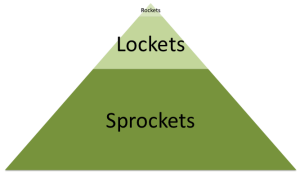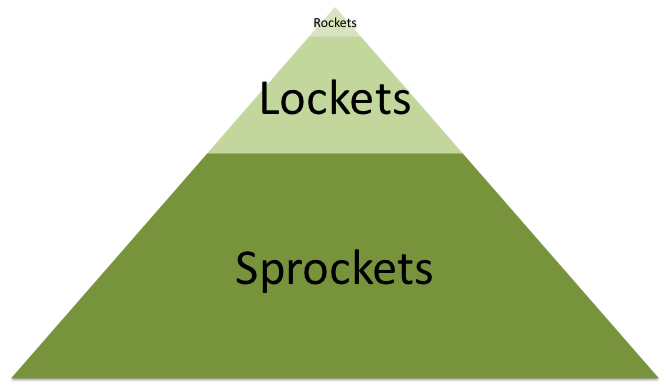This is something I wrote for my MSc dissertation ('Playing with difficult objects: game designs for crowdsourcing museum metadata', view the games I built for it at http://museumgam.es/ or check out the paper (Playing with Difficult Objects – Game Designs to Improve Museum Collections) I wrote for Museums and the Web 2011) about the role of 'distinctiveness' in mental models about collections, that's potentially relevant to discussions around telling stories with and collecting metadata about museum collections. I'm posting it here for reference in the conversation about instances vs classes of objects that arose on the UKMCG list after the release of NMSI (Science Museum, National Media Museum, National Railway Museum) data as CSV. One reason I've been thinking about 'distinctiveness' is because I'm wondering how we help people find the interesting records – the iconic objects, the intriguing stories – in a collection of 240,000 objects.
I'm interested in audiences' mental models about when a record refers to the type of object vs the individual object – my sense is that 'rockets', in the model below, are generally thought of as the individual object, and that 'sprockets' are thought of as the type of object, but that it varies for 'lockets', depending how distinctive they are in relation to the person.
I'm also generally curious about the utility of the model, and would love to know of references that might relate to it (whether supporting or otherwise) – if you can think of any, let me know in the comments.
Not all objects are created equal
Both museum objects and the records about them vary in quality. Just as the physical characteristics of one object – its condition, rarity, etc – differ from another, the strength of its associations with important people, events or concepts will also vary. To complicate things further, as the Collections Council of Australia (2009) states, this 'significance' is 'relative, contingent and dynamic'.
When faced with hundreds of thousands of objects, a museum will digitise and describe objects prioritised by 'technical criteria (physical condition of the original material), content criteria (representativeness, uniqueness), and use criteria (demand)' (Karvonen, 2010). In theory, all objects are registered by the collecting institution, so a basic record exists for each. Hopefully, each has been catalogued and the information transcribed or digitised to some extent, but this is often not the case. Records are often missing descriptions, and most lack the contextual histories that would help the general visitor understand its significance. Some objects may only have an accession number and a one word label, while those on display in a museum generally have well-researched metadata, detailed descriptions and related narratives or contextualised histories. Variable image quality (or lack of images) is an issue in collections in general. This project excludes object records without images but does include many poor-quality images as a result of importing records from a bulk catalogue.
This project posits that objects can be placed on a scale of 'distinctiveness' based on their visual attributes and the amount and quality of information about them. Within this project, bulk collections with minimal metadata and distinctiveness have been labelled 'sprockets', the smaller set of catalogued objects with some distinctiveness have been labelled 'lockets', and the unique, iconic objects with a full contextual history have been labelled 'rockets'. This concept also references the English Heritage 'building grades' model (DCMS, 2010). During the project, the labels 'heroic', 'semi-heroic' and 'bulk' objects were also used.
These labels are not concerned with actual 'significance' or other valuation or priority placed on the object, but relate only to the potential mental models around them and data related to them – the potential for players to discover something interesting about them as objects, or whether they can just tag them on visual characteristics.
In theory there is a correlation between the significance of an object and the amount of information available about it; there may be particular opportunities for games where this is not the case.
Project label
Information type
Amount of information
Proportion of collectionRockets Subjective Contextual history ('background, events, processes and influences') Tiny minority Lockets Mostly objective, may be contextual to collection purpose Catalogued (some description) Minority Sprockets Objective Registered (minimal) Majority
Table 1 Objects grouped by distinctiveness
This can also be represented visually as a pyramid model:
 |
| Figure 2 A figurative illustration of the relative numbers of different levels of objects in a typical history museum. |
References
Department of Media, Culture and Sport (DCMS) (2010) Principles of Selection for Listing Buildings [Online] Available from: http://www.english-heritage.org.uk/content/imported-docs/p-t/principles-of-selection-for-listing-buildings-2010.pdf
Karvonen, M. (2010). "Digitising Museum Materials – Towards Visibility and Impact". In Pettersson, S., Hagedorn-Saupe, M., Jyrkkiö, T., Weij, A. (Eds) Encouraging Collections Mobility In Europe. Collections Mobility. [Online] Available from: http://www.lending-for-europe.eu/index.php?id=167
Russell, R., and Winkworth, K. (2009). Significance 2.0: a guide to assessing the significance of collections. Collections Council of Australia. [Online] Available from: http://significance.collectionscouncil.com.au/

Thank you for an interesting classification! What do you think could be done with the last category to bring the objects to light? Do you think of crowdsourcing metadata? Building histories and contexts? Creating a game of collecting unknown objects around a portrait of their hypothetical owner? (say, a known portrait of a nineteenth century English gentleman). Giving them a point on a timeline and a place on a world map? How is it connected to your doctoral research?
Thanks for your comment! Funnily enough, I've looked again at my post and I didn't link to the metadata crowdsourcing games I built for my MSc project – they're at http://museumgam.es/
My doctoral research is on crowdsourcing but not directly through games.
Cheers, Mia
Quickly posting about an idea I'm still thinking through… I wonder what the intersection of Bernard Herman's object-centred and object-driven models with the internal models that underly how museums categorise and prioritise objects above might yield?
http://www.open.edu/openlearn/history-the-arts/culture/visual-art/introduction-material-culture/content-section-2.1
"an ‘object-centred’ approach to the subject, one in which the focus of study is on the object itself. Here, we need to pay attention to the specific physical attributes of the object. The ability to describe the object – to engage, that is, with a list of descriptive criteria – is at the forefront of this approach. A typical checklist of the kinds of questions we might ask about an object include:
how, and with what materials, was the object made?
what is its shape, size, texture, weight and colour?
how might one describe its design, style and/or decorative status?
when was it made, and for what purpose?"
http://www.open.edu/openlearn/history-the-arts/culture/visual-art/introduction-material-culture/content-section-2.2
"Herman has identified a second strand to material culture studies, one which he describes as ‘object-driven’. Here, the focus shifts toward an emphasis on understanding how objects relate to the peoples and cultures that make and use them. In particular, ideas about contextualisation and function become all important. As we have already noted, what objects mean may change through time and space. As products of a particular time and place, objects can tell us a great deal about the societies that gave birth to them. That is, they often help to reflect, or speak to us, of the values and beliefs of those who created them. At the same time, it is also important to remember that objects are not simply ‘passive’ in this way, but that they can also take on a more ‘active’ role, helping to create meaning rather than simply reflect it."
The articles reference Herman, B.L. (1992) The Stolen House, Charlottesville, University Press of Virginia.